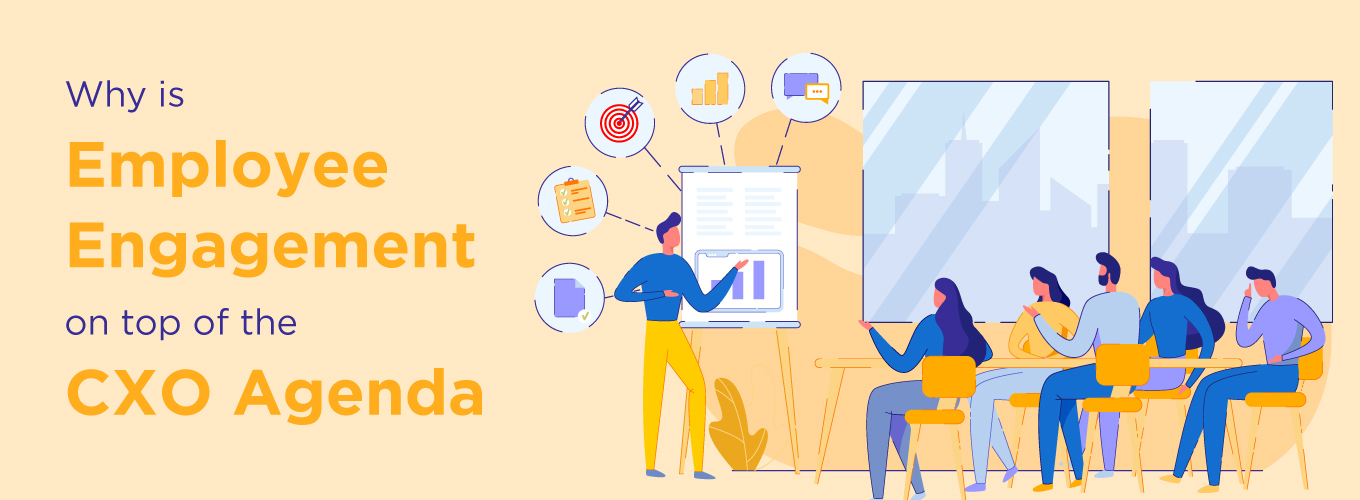Why is Employee Engagement on top of the CXO Agenda
Every organization looks at making employee engagement as a primary agenda because engaged employees are more involved in the company. This results in better communication, a positive work environment and pride in working for the company. Overall, invested employees are happier.
Employee engagement activities therefore become one of the primary objectives of CXOs. An effective employee engagement plan can boost employee morale, making employees more productive and valuable to the company. CXOs can engage with employees effectively by allowing employees to share their ideas and implementing these ideas to better the company. CXOs should also connect with employees personally and create a good rapport with them.
Why is employee engagement important?
-
Improved productivity
An engaged employee is more involved with the company. When this happens, productivity goes up and there is smooth functioning in the organization. A positive work environment creates a sense of pride of working in the organization. Employees are happier and there is a sense of well-being throughout the organization.
-
Increased customer satisfaction
Engaged employees interact better with the customers of a company. Engaged employees are more passionate about their work, which creates a positive impression on customers. Better involvement of employees with customers can lead to better customer satisfaction and retention.
-
Increased employee retention
Employee retention is a priority of most management and they work very hard at implementing strategies for retention so that employees stay engaged and committed. Attrition happens when employees lose faith in the management and the operations of the company and often when a top employee leaves, others follow. A good retention strategy will ensure that employees feel nurtured, wanted, and fulfilled at their workplace.
-
Enhanced company culture
When people experience a good, happy vibe at the workplace, the work culture thrives and is positive in nature. Putting employee engagement and satisfaction as a core value, communicating it effectively and ensuring that it is followed can all lead to a good and vibrant culture. Good work culture is also fostered when leaders seek feedback from employees, there is good work-life balance and the employees are happy.
-
Contribution to innovation
Innovation is a great vitalizer in organizations. When employees are creatively engaged and given a chance to innovate and solve issues, they feel more engaged and interested in their work. Every organization must allow for innovative ideas to flow. Listening and implementing these innovations can boost employee morale and give the leaders a chance to engage meaningfully with employees.
-
Better employee relations
Ensuring effective communication channels is a key focus area for CXOs. Internal channels must promote open communication and a good flow of information. This will give employees confidence and ensure good employee relations. Any areas of disengagement can easily be spotted and addressed effectively when communication channels function well. A free flow of information from CXOs downward will lead to good employee relations.
-
Healthier employees
The physical and mental well-being of employees directly impacts employee engagement. Companies use various methods to promote a healthy and happy workforce. They work on better work-life balance, opportunities for team-bonding and facilities for physical exercise. Some companies work on ergonomic furniture in the office, promoting mental well-being by providing ample greenery, soft lighting, and opportunities for the emotional well-being of employees by addressing their work stress. Supporting employees with all these will lead them to be better engaged and involved with the organization.
-
Happier personal lives
Most employees tend to carry their work or their stress back to their homes after work. It is important to encourage them to lead more balanced lives and spend more time with their family and friends. This will ensure that they are revitalized and energetic when they come back to office the next day.
-
A good reputation
Ensuring a positive work atmosphere will impact various organizational stakeholders. For instance, a positive work culture impacts customers, vendors, and their relationships within the organization positively. A good internal experience reflects on how the community and people outside the organization perceive your organization. A good reputation means that all stakeholders whether they are internal or external have a good perception about the organization.
-
Talent attraction
CXOs must ensure that employees are respected and create a comfortable working environment. When a workplace does this and encourages diversity, innovation and also rewards employees well, it serves as a magnet to attract talent towards the organization. When employee goals align with those of the organization, magic happens and an organization can move ahead by leaps and bounds. Talented people join organizations where they feel respected and encouraged.
Conclusion
Employee engagement initiatives build a happy and engaged workplace. Happy and enthusiastic employees go the extra mile to work for their organization with an improved work culture and higher profits and better results. Productivity of such organizations is high and there is a sense of pride and motivation among the employees. As CXOs, when these conditions are met, it is easier to lead an organization to success and provide a higher level of service to your customers.









